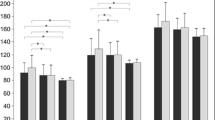Abstract
We studied the relationship between abnormalities shown by MRI and functional disturbances in the visual pathway as assessed by the visual evoked potential (VEP) in 25 patients with established multiple sclerosis (MS); only 4 of whom had a history of acute optic neuritis. Optic nerve MRI was abnormal in 19 (76 %) and is thus useful in detecting subclinical disease. Optic nerve total lesion length and area on the STIR sequence was found to correlate significantly with prolongation of the VEP latency. This may reflect a predominantly demyelinating rather than inflammatory origin for the signal change in the optic nerve.
Similar content being viewed by others
Author information
Authors and Affiliations
Additional information
Received: 21 July 1997 Accepted: 1 April 1998
Rights and permissions
About this article
Cite this article
Davies, M., Williams, R., Haq, N. et al. MRI of optic nerve and postchiasmal visual pathways and visual evoked potentials in secondary progressive multiple sclerosis. Neuroradiology 40, 765–770 (1998). https://doi.org/10.1007/s002340050681
Issue Date:
DOI: https://doi.org/10.1007/s002340050681




